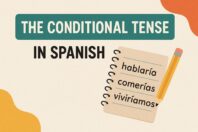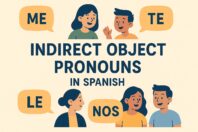El vs La: Spanish nouns with dual personalities

Get our free email course, Shortcut to Conversational.
Have conversations faster, understand people when they speak fast, and other tested tips to learn faster.
More infoIn Spanish, nouns typically have a fixed gender, either masculine or feminine. Knowing a word’s gender is an essential part of learning Spanish nouns, whether by always including their articles such as el vs la in Spanish, or by recognizing other markers such as gender-specific word endings.
Despite the normal rule of Spanish gendered nouns being either masculine or feminine, there are certain nouns that can be either one depending on the gender of the person being referred to. This is particularly the case for nouns describing some occupations and nationalities in Spanish. For these words, applying one gender or the other does not alter their meaning, but simply reflects the gender of the individual.
On the other hand, there are some nouns that can be either masculine or feminine, but whose meaning differs depending on whether they are used in one gender or the other. We’ll refer to these as el vs la nouns, and they’ll be our primary focus in this post.
As a plus, we’ll also have a look at the professions and nationalities in Spanish that don’t change spelling to reflect their gender, so you can have a better picture of the differences between these two groups of Spanish dual-gendered nouns.
Let’s get started!
El vs La: Meaning changes in Spanish nouns
In understanding Spanish gender rules, we need to recognize that while many word endings may provide clues as to a noun’s gender, the use of articles will clearly indicate whether it is masculine vs feminine. This feature of the Spanish language can sometimes lead to different meanings for the same word, depending on whether it is used as a masculine noun or a feminine one.
For the el vs la nouns we’ll look at here, the word itself stays the same, but the gender, and thus the word’s meaning, is defined by the article which precedes it.
As a reminder, the Spanish definite and indefinite articles el and un are masculine, while la and una are feminine. For more detail on these, check out our full post on Spanish articles.
El capital vs La capital
When used as a masculine noun, el capital refers to financial assets or resources.
When used as the feminine la capital, it designates a city that serves as the seat of government or administrative center of a country.
- Debemos tener el capital necesario para ampliar la empresa. – We must have the necessary funds to expand the company.
- Bogotá es la capital de Colombia. – Bogota is the capital city of Colombia.
El corte vs La corte
As a masculine noun, el corte means a cut or a division.
The feminine la corte refers to a court of law or the royal court.
- El corte de cabello en capas es la tendencia de este verano. – The layered haircut is this summer’s trend.
- El corte favorito de Carla es la chuleta de aguja. – Carla’s favorite cut is the rib chop.
- La Corte Suprema de Justicia falló a favor del presidente. – The Supreme Court of Justice ruled in favor of the president.
- Ana Bolena era la noble más hermosa de la corte. – Anne Boleyn was the most beautiful noblewoman in her court.
El coma vs La coma
The masculine form el coma refers to a state of unresponsiveness from which the patient cannot be awakened, also known as a coma in English.
The feminine form la coma refers to a punctuation mark, known in English as a comma.
- El coma fue inducido para la seguridad del paciente. – The coma was induced for the patient’s safety.
- A tu texto le faltan todas las comas. No se puede leer fácilmente. – Your text is lacking all commas. It cannot be read easily.
El cólera vs La cólera
El cólera in its masculine form refers to the cholera disease.
The feminine noun la cólera means anger, rage, or wrath.
- El cólera es una enfermedad infecciosa muy peligrosa. – Cholera is a very dangerous infectious disease.
- La cólera que sintió Olga cuando se enteró que habían perdido su vestido fue incontenible. – The anger Olga felt when she found out they had lost her dress was uncontainable.
El cura vs La cura
The masculine el cura is a colloquial way to refer to a catholic priest.
In feminine, la cura signifies a cure or remedy. In some countries, like Colombia and Venezuela, la cura is also a regional name for the avocado fruit.
- El cura del pueblo es muy sabio y amable. – The village priest is very wise and kind.
- El tiempo es la cura para un corazón roto. – Time is the cure for a broken heart.
- La cura que me regaló la vecina ya está madura. – The avocado that the neighbor gave me is already ripe.
El frente vs La frente
El frente as a masculine noun means the front, used like in English to describe a relative location.
La frente, on the other hand, means forehead.
- El frente de la Torre Colón está muy desgastado. – The front of the Colón Tower is very worn.
- General, los soldados ya están listos para luchar en el frente. – General, the soldiers are now ready to fight on the front.
- Esos zapatos tienen detalles muy bonitos en el frente. – Those shoes have very nice details on the front.
- Mi abuela siempre me da un beso de buenas noches en la frente. – My grandmother always kisses me goodnight on my forehead.
El margen vs La margen
As a masculine noun, el margen refers to a margin, in the sense of a an edge or border of something.
In feminine, la margen refers to a riverbank. This meaning can also be intended by using the masculine noun, though when we’re referring to a riverbank it is much more common to use the feminine form.
- Luis, respeta el margen de la página para que la tarea se vea más ordenada. – Luis, respect the page’s margin to make the task look neater.
- El margen de error de esta maniobra es del uno por ciento. – The margin of error for this maneuver is one percent.
- En la margen derecha del río hay algunas casas de bambú. – On the right bank of the river there are some bamboo houses.
El orden vs La orden
The masculine noun el orden denotes order in the broad sense of being organized, or as a specific rule or manner observed in doing things.
As a feminine noun, la orden also translates as an order in English, in the sense of a command or a request, whether to carry out some action or to supply or deliver a product. Also like in English, una orden refers to an order, identifying exclusive civilian, military, or religious societies or institutions.
- Es necesario recoger lo que esté tirado y limpiar el suelo para mantener el orden. – It is necessary to pick up what is thrown away and clean the floor to keep in order.
- El orden de los factores no altera el producto. – The order of the factors does not alter the product.
- El director dio la orden de tocar esta pieza aunque no la hayamos ensayado. – The conductor gave the order to play this piece even though we have not rehearsed it.
- La orden de compra que me entregaron es ilegal. – The purchase order I was given is illegal.
- ¿Cuál fue la orden del caballero? / Un croissant y un café con leche. – What was the gentleman’s order? / A croissant and a latte.
- La Orden Civil de Alfonso X se estableció en 1939. – The Civil Order of Alfonso X was established in 1939.
- Se rumora que hay una orden secreta muy antigua en la universidad. – Rumor has it that there is an ancient secret order at the university.
El Papa vs La papa
The capitalized masculine form, el Papa, refers to the Pope, who is the head of the Catholic Church.
The feminine form, la papa, means potato.
- El Papa Francisco hizo una visita a todos los pueblos del Caribe. – Pope Francis made a visit to all the nations of the Caribbean.
- Me encantan las papas, en especial al horno. – I love potatoes, especially baked.
El radio vs La radio
As a masculine noun, el radio has several meanings, generally translated into English as a radius. In the field of geometry, it denotes a radius, which is a linear segment that connects the center of a circle to any point on its circumference. This same concept applies when referring to the rods extending from the center to the periphery of a wheel, where los radios in English are called spokes. In the field of anatomy, el radio is one of the two bones in the forearm, also called the radius, which is slightly shorter than the ulna.
As a feminine noun, la radio refers to the radio, both as the electronic device and as the general form of media.
- Estudiantes, deben calcular el radio de esta circunferencia. – Students, you must calculate the radius of this circle.
- El niño se cayó del árbol y se fracturó el radio. – The boy fell out of the tree and broke his radius.
- Está sonando mi canción favorita en la radio. – My favorite song is playing on the radio.
- Mi papá trabaja en la radio. Todos los días entrevista a gente muy famosa. – My dad works at the radio station. Every day he interviews very famous people.
El editorial vs La editorial
The noun el editorial in its masculine form is similar to its English counterpart, used to describe an unsigned article expressing the opinion of a newspaper’s editorial board.
La editorial, in the feminine form, refers to a publisher or a publishing house, namely a company dedicated to publishing books, newspapers, and other written texts through printing or other means.
- El editorial del periódico hizo una crítica muy aguda al gobierno de ese país. – The newspaper’s editorial made a very sharp criticism of that country’s government.
- La editorial de mi hermana solo publica obras infantiles. – My sister’s publishing house only publishes works for children.
El guía vs La guía
Guía is a particular noun which can translate as guide in both genders. When referring to the profession of a guide or a tour leader, using el guía vs la guía will indicate the gender of the individual.
The feminine form has yet another specific meaning, with la guía meaning a guidebook. It’s important to be aware of the context to know whether la guía is referring to a female guide or to a guidebook.
- El guía nos dijo que no tomaramos el camino de la izquierda. – The (male) guide told us not to take the left path.
- La guía fue muy amable y nos cuidó a todos durante la excursión. – The (female) guide was very friendly and took care of all of us during the tour.
- Todas las instrucciones y números telefónicos están en la guía que te di. – All the instructions and phone numbers are in the guidebook I gave you.
El policía vs La policía
Similarly to the previous noun, when referring to the profession, el policía means policeman and la policía can mean policewoman.
The feminine form la policía can also refer to the overall police force as an institution.
- El policía está patrullando las calles. – The policeman is patrolling the streets.
- La policía tiene puesto el uniforme y tiene su placa. – The policewoman is in uniform and has her badge.
- La policía es fundamental en la lucha contra el crimen. – The police are fundamental in the fight against crime.
El pendiente vs La pendiente
El pendiente, as a masculine noun, refers to an earring or an item of jewelry worn on the earlobe.
La pendiente, as a feminine noun, signifies a slope or incline, particularly in a geographical or mathematical context. It describes the steepness or gradient of a surface or path.
- La tía Sandra está usando los pendientes de zafiro que le regaló papá. – Aunt Sandra is wearing the sapphire earrings dad gave her.
- No corras cerca de la pendiente, te puedes hacer daño. – Don’t run near the slope, you could hurt yourself.
Spanish professions with no gender change
In Spanish, most nouns for professions and occupations have distinct gender markers to distinguish whether the individual is a man or a woman. In most cases, the masculine version of the profession either ends in an -o or has some other neutral form, while the feminine version ends in an -a. One such example is el doctor vs la doctora for a male vs female doctor.
However, as mentioned earlier, there are certain nouns for professions in Spanish where the form remains the same. For these professions, the gender of the person can only be distinguished through the context and the accompanying words, especially the articles el vs la.
It’s worth noting some nouns have developed a distinct feminine form over time, giving us an option to use either the neutral form or the newer feminine word. Let’s take a look:
| Masculine | Feminine | English |
| El estudiante | La estudiante | The student |
| El periodista | La periodista | The journalist |
| El dentista | La dentista | The dentist |
| El modelo | La modelo | The model |
| El policía | La policía | The policeman, The policewoman |
| El testigo | La testigo | The witness |
| El piloto | La piloto | The pilot |
| El turista | La turista | The tourist |
| El artista | La artista | The artist |
| El chef | La chef | The chef |
| El cliente | La cliente, La clienta | The client |
| El poeta | La poeta, La poetisa | The poet |
| El presidente | La presidente, La presidenta | The president |
Spanish nationalities with no gender change
The same Spanish gender nuances that we just saw with some professions also occur with many nationalities. Most nationalities in Spanish have distinctive gender markers, such as the -a at the end of the word for the feminine and -o for masculine. Again, there are some nationalities which have the same base form: we can only identify the gender of the individual they describe through accompanying words such as the articles el vs la. Let’s take a look:
| Masculine | Feminine | English |
| El estadounidense | La estadounidense | The American |
| El canadiense | La canadiense | The Canadian |
| El belga | La belga | The Belgian |
| El costarricense | La costarricense | The Costa Rican |
| El israelí | La israelí | The Israeli |
| El marroquí | La marroquí | The Moroccan |
| El pakistaní | La pakistaní | The Pakistani |
| El iraquí | El iraquí | The Iraqi |
| El iraní | La iraní | The Iranian |
| El croata | La croata | The Croat, The Croatian |
| El vietnamita | La vietnamita | The Vietnamese person |
| El singapurense | La singapurense | The Singaporean |
Conclusion
Good job! Now you know a lot more about some specific Spanish language nuances, particularly on how a word’s gender can indicate meaning changes in Spanish nouns. Now, what do you say we do a quick review to wrap things up?
Today we learned that while most nouns have fixed gender markers, a few keep the same form and change their meaning depending on whether they are used as masculine or feminine. We’ve been referring to these as el vs la nouns, and they highlight the importance of context and the accompanying articles in determining a word’s intended meaning.
Additionally, we saw how professions and nationalities in Spanish also exhibit variations through gender markers. While most professions and nationalities have distinct masculine and feminine forms, there are some nouns whose form remains the same, with the gender indicated by the articles el vs la in Spanish, or by other accompanying words.
Understanding Spanish gender rules is crucial for effective communication, enabling you to express your intended meaning accurately and avoid misunderstandings. If you found this post useful go ahead and share it with your Spanish-learning friends, so they don’t mix up Pope and potato ever again!



